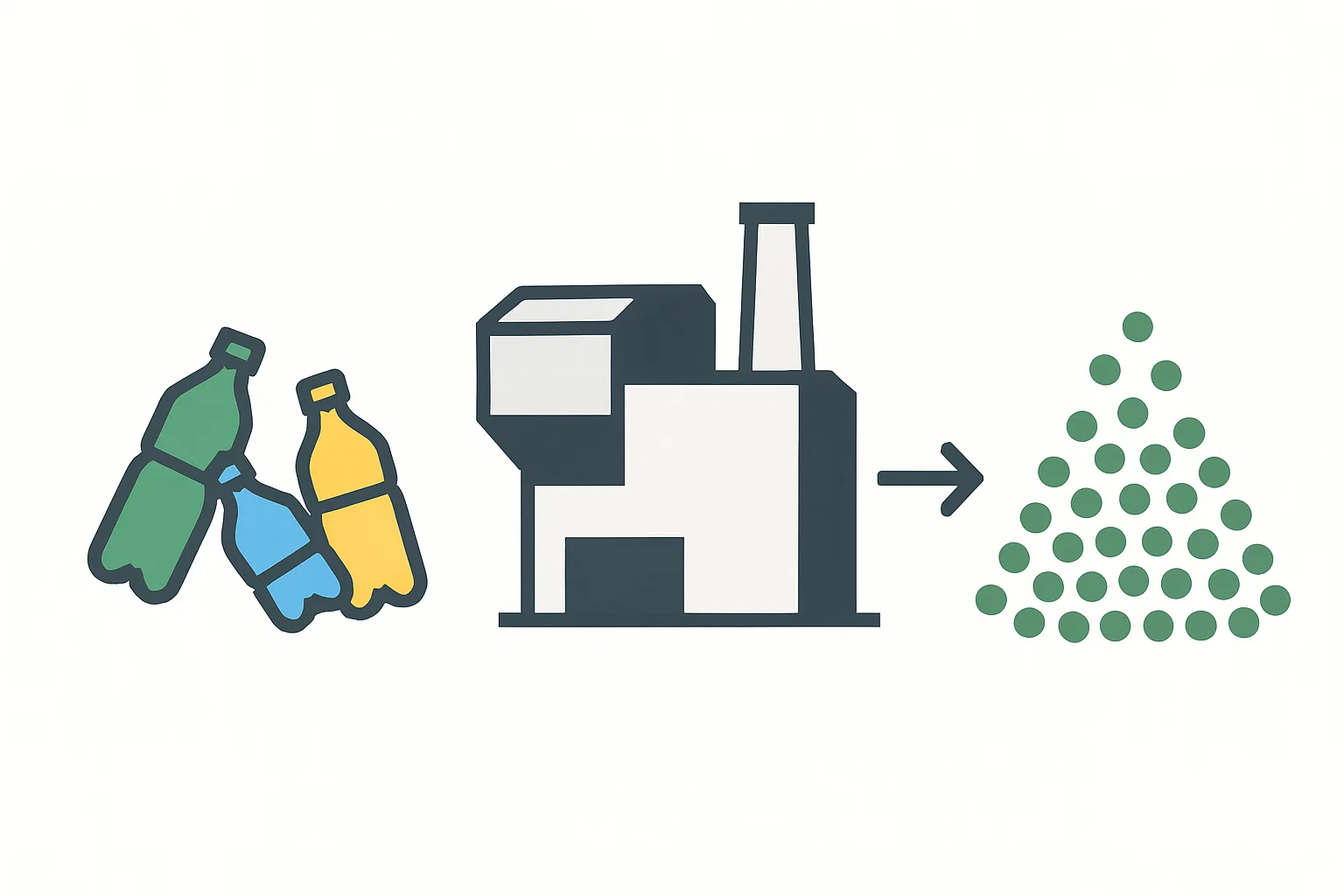In today’s manufacturing landscape, the circular economy is no longer a niche concept but a commercial imperative. Transforming industrial waste into high-quality, reusable raw materials is crucial for sustainability, regulatory compliance, and economic advantage. However, the process behind this transformation can often seem like a black box. What truly happens inside an industrial waste recycling machine?
For manufacturers, recycling facility operators, and equipment buyers, understanding this process is fundamental to making informed investment decisions. A recycling line isn’t a single piece of equipment but a sophisticated, integrated system where each stage is vital for the success of the next.
At Energycle Machine, we specialise in designing and building these robust systems. With years of hands-on experience, we’ve seen first-hand how a well-optimised recycling line can unlock significant value from waste streams. This guide will demystify the industrial recycling process, breaking it down step-by-step to provide the clarity and technical insight industry professionals need.
The Core Concept: From Contaminated Waste to Valuable Raw Material
The primary goal of any waste recycling machine or system is to take a heterogeneous, often contaminated, stream of post-industrial or post-consumer waste and convert it into a clean, uniform, and valuable commodity. This commodity, typically in the form of pellets or high-quality flakes, can then re-enter the manufacturing cycle, reducing the reliance on virgin materials.
The journey from waste to resource typically involves five key stages:
- Sorting and Separation
- Size Reduction (Shredding & Crushing)
- Purification (Washing & Cleaning)
- Drying and Dewatering
- Final Transformation (Melting & Pelletising)
Let’s explore what happens at each of these critical stages of recycling.
Stage 1: The Crucial First Step – Sorting and Separation
The quality of your final recycled product is determined at the very beginning of the process. Effective sorting is non-negotiable, as contamination is the single biggest threat to producing high-value recyclate. The goal here is to isolate the target material (e.g., PET bottles, HDPE drums, PP film) from all other materials, such as different plastic types, metals, paper, and organic waste.
Manual Sorting
Even in the most advanced facilities, manual sorting often plays a role. Operatives on a sorting line visually identify and remove large contaminants, incorrect material types, and items that could damage downstream machinery. While labour-intensive, it provides a crucial layer of quality control that automated systems can sometimes miss.
Automated Waste Sorting Technology
For high-volume industrial applications, automation is key. Modern recycling lines employ a range of sophisticated waste sorting technology:
- Ballistic Separators: These machines use paddles to separate materials based on their physical properties, effectively sorting 2D materials (films, paper) from 3D materials (containers, bottles).
- Magnetic Separators: Powerful overhead belt magnets or magnetic drums are used to pull out ferrous metals (steel, iron) from the waste stream.
- Eddy Current Separators: These are used to eject non-ferrous metals like aluminium cans and foil. A high-speed rotating magnetic rotor induces an “eddy current” in the metal, which creates a repulsive force that throws it from the conveyor belt.
- Near-Infrared (NIR) Spectroscopy: This is the pinnacle of plastic sorting technology. As materials pass under NIR sensors, light is shone onto them. Each type of polymer reflects the light in a unique way, creating a “fingerprint.” The sensor identifies the material and uses precisely targeted air jets to blow it onto the correct conveyor, achieving highly accurate separation of plastics like PET, HDPE, and PP.
A well-designed sorting stage, combining both manual and automated elements, is the foundation upon which the entire plastic recycling machine process is built.
Stage 2: Size Reduction – Shredding and Crushing
Once the material is sorted, it needs to be reduced to a smaller, more uniform size. This serves several purposes: it makes the material easier to handle and convey, liberates trapped dirt and contaminants, and increases the surface area for a more effective washing process.
The Role of the Industrial Shredder
For bulky or tough materials like plastic purgings, drums, or baled film, the primary size reduction is done by an industrial shredder. How does a plastic shredder work? It typically uses one or two slow-rotating shafts equipped with heavy-duty cutting knives. This slow-speed, high-torque operation allows it to powerfully tear and cut through dense materials without generating excessive heat or fines (dust). The output size is controlled by a screen fitted beneath the cutting chamber.
Granulators and Crushers
Following the initial shred, or as the primary step for less bulky items like bottles, a granulator (or crusher) is used. Granulators operate at a much higher speed than shredders. An open rotor with angled knives cuts the material against stationary bed knives, quickly chopping it into small, uniform flakes or “regrind.”
Choosing the right size reduction equipment is critical. An improperly sized shredder or granulator can be a major bottleneck. The team at Energycle Machine helps clients select the optimal machinery based on their specific waste type, volume, and desired throughput, ensuring the entire line operates smoothly.
Stage 3: The Purification Process – Washing and Cleaning
This is where the real transformation begins. The shredded and granulated material is still covered in contaminants like dirt, sand, food residue, glues from labels, and oils. The importance of waste washing in recycling cannot be overstated; it is this stage that elevates the material’s quality and value.
A complete washing line is a multi-step system designed to use friction, density, and temperature to achieve purity.
- High-Friction Washer/Scrubber: The plastic flakes are fed into a high-speed machine where paddles or screws scrub them against each other and against the machine’s surfaces in the presence of water. This intense mechanical action effectively dislodges stubborn dirt and paper labels.
- Float-Sink Tanks: This is a clever use of physics to separate materials by density. The mixed plastic flakes are submerged in a large tank of water. Heavier plastics like PET (Polyethylene Terephthalate) will sink, while lighter polyolefins like PE (Polyethylene) and PP (Polypropylene) will float. This is a highly effective and energy-efficient way to separate different polymer types.
- Hot Washing Systems: For materials with heavy contamination from oils, grease, or stubborn glues, a hot wash is necessary. Flakes are washed in hot water (typically 60-85°C) with the addition of a caustic soda or detergent solution. This saponifies fats and dissolves glues, ensuring a pristine final product.
A robust washing stage is essential for any serious recycling operation. For a deeper dive into this critical stage, explore our comprehensive recycling washing systems, which are designed for maximum efficiency and cleaning power.
Stage 4: Removing Moisture – Dewatering and Drying
After the intensive washing process, the plastic flakes are saturated with water. This moisture must be removed before the final melting stage, as any residual water can degrade the polymer and create imperfections in the final product.
The dewatering process in plastic recycling is usually a two-step process:
- Mechanical Dewatering: The wet flakes are first sent through a centrifugal dryer or a screw press. These machines use mechanical force to squeeze out the bulk of the free-flowing water, typically reducing the moisture content from over 30% down to under 5-10%. This is a very energy-efficient first step.
- Thermal Drying: To remove the remaining surface moisture, the flakes are passed through a thermal drying system. This usually involves conveying the flakes through a stream of hot air in a series of stainless-steel pipes. The system is carefully calibrated to bring the moisture content down to the required level (often less than 1%) without overheating or melting the plastic. Energycle Machine drying systems are engineered for this precise temperature control.
Stage 5: The Final Transformation – Melting and Pelletising
This is the final stage, where the clean, dry flakes are converted back into a uniform, easily processable raw material. This is achieved using a pelletising machine for recycled plastic, which is essentially a specialised extruder.
The Extrusion Process
The clean flakes are fed into the hopper of an extruder. A large, rotating screw conveys the flakes along a heated barrel. The combination of heat from the barrel and shear friction from the screw’s movement melts the plastic into a homogenous molten polymer. During this process, additives like colourants, UV stabilisers, or processing aids can be mixed in. The molten plastic is then forced through a screen pack (melt filter) to remove any final, minute contaminants like fine metal or carbonised particles.
Pelletising Systems
Once the molten polymer exits the extruder die head, it needs to be cut into pellets. The two most common methods are:
- Strand Pelletising: The molten plastic is extruded as long strands, like spaghetti, which are cooled in a water bath before being fed into a pelletiser that cuts them into small cylinders.
- Underwater Pelletising: The die head is submerged in a water-filled chamber. As the molten plastic exits the die, a rotating cutting head immediately slices it into small, spherical pellets, which are instantly cooled and solidified by the water. This method produces more uniform pellets and is often preferred for high-volume, high-quality applications.
The resulting pellets are the final product—a high-quality, recycled raw material ready to be sold or used in the manufacturing of new products, thus closing the loop.
Bringing It All Together: The Energycle Machine Advantage
Understanding what are the stages of recycling reveals that a successful operation depends on more than just individual machines. It requires a seamlessly integrated system where each component is perfectly matched to the others. The benefits of a complete recycling line designed by a single, expert provider include optimised throughput, reduced energy consumption, consistent output quality, and a single point of responsibility for service and support.
At Energycle Machine, we don’t just sell equipment; we provide end-to-end Energycle Machine recycling solutions. We work closely with our clients to understand their specific feedstock and quality requirements, designing customised lines that deliver performance, reliability, and a strong return on investment. Our expertise ensures you are not just buying a waste recycling machine, but investing in a profitable and sustainable future for your business.
Frequently Asked Questions (FAQ)
1. What types of waste can these machines process?
Industrial recycling lines can be configured to process a wide range of materials. For plastics, this includes rigid plastics like HDPE drums and crates, PET bottles, and post-industrial PP or PS parts. They can also be designed specifically for soft plastics like LDPE/LLDPE films from commercial or agricultural sources. Each line is optimised for the specific material’s characteristics.
2. How much space is required for a complete waste recycling line?
The footprint varies significantly based on the line’s capacity and complexity. A simple, low-capacity line might fit in a few hundred square metres, while a high-volume, fully automated system with extensive sorting and washing can require several thousand square metres. A key part of the service from Energycle Machine is providing layout designs to optimise the line for your available space.
3. What is the most critical factor for producing high-quality recycled material?
While every stage is important, the most critical factors are the initial sorting and the thoroughness of the washing stage. You cannot make high-quality material from a contaminated feedstock. Removing contaminants (other plastics, metals, paper, dirt, and glues) as early and effectively as possible is the key to producing a valuable final product.
4. How does Energycle Machine ensure the reliability of its equipment?
We build our machines using high-quality components, robust steel frames, and wear-resistant materials for all contact parts. Our designs are based on years of field experience, focusing on ease of maintenance and operational stability. Furthermore, we provide comprehensive technical support, operator training, and spare parts services to ensure maximum uptime and a long service life for your investment.
Conclusion: Partnering for a Sustainable Future
A waste recycling machine is far more than a simple piece of equipment; it is a sophisticated system that embodies the principles of the circular economy. By transforming industrial and post-consumer waste into valuable resources, these systems play a vital role in creating a more sustainable and efficient manufacturing sector.
Choosing the right waste recycling machine and, more importantly, the right partner is a decision that will impact your operations for years to come. A partner with proven experience, technical expertise, and a commitment to quality is essential.
If you are ready to explore how an industrial recycling system can benefit your business, contact the experts at Energycle Machine today. We are here to help you navigate the complexities of recycling and build a solution that delivers results.



